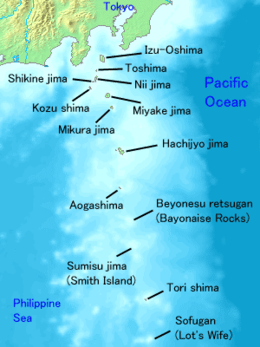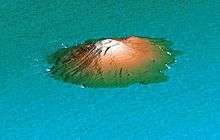Devil's Sea




The Devil's Sea (魔の海 Ma no Umi), also known as the Dragon's Triangle, the Formosa (Taiwan) Triangle (traditional Chinese: 福爾摩沙三角; simplified Chinese: 福尔摩沙三角; pinyin: Fúěrmóshā Sānjiǎo) and the "Pacific Bermuda Triangle", is a region of the Pacific around Miyake Island, about 100 km south of Tokyo. The Devil's sea is sometimes considered a paranormal location, though the veracity of these claims has been soundly debunked. The size and area varies with the report (the only reports stem from the 1950s), with various reports placing it 110 kilometres (68 mi) from an unspecified part of Japan's east coast, 480 kilometres (300 mi) from the coast, and even near Iwo Jima, 1,200 kilometres (750 mi) from the coast.[1]
The Japanese research vessel that Berlitz named, Kaiyo Maru No 5, had a crew of 31 aboard. While investigating activity of an undersea volcano, Myōjin-shō, about 300 km south of the Devil's Sea, it was destroyed by an eruption on 24 September 1952. Some wreckage was recovered.[2] At least one ship sent an SOS. The other seven boats were small fishing boats lost between April 1949 and October 1953 somewhere between Miyake Island and Iwo Jima, a distance of 1,200 kilometres (750 mi).[3]
In popular culture
Games
- The 2013 installment of the Tomb Raider videogame series features a young Lara Croft shipwrecked on an island in the Dragon's Triangle, in search of the lost Kingdom of Yamatai.
Literature
- In James Rollins' action-adventure novel Deep Fathom, Air Force One mysteriously crashes in the Dragon's Triangle, in the same location where numerous other aircraft and vessels have been lost, a mysterious crystal column has formed, and a series of devastating tectonic events has originated.
- In Lisa McMann's The Unwanteds: Island of Dragons, Kaylee thinks her friends' magical world is in the Dragon's Triangle with no way out.
Manga
- The manga Cage of Eden takes place on an unmapped island in the Dragon's Triangle.
Television and anime
- The Umibōzu arc of the anime Mononoke takes place within the Dragon's Triangle.
Criticisms
In 1995, American author Larry Kusche published The Bermuda Triangle Mystery Solved, debunking Berlitz’s claims about both the Bermuda Triangle and Dragon’s Triangle. Kusche’s research claimed that Berlitz’s military vessels were actually fishing vessels, and some of those listed by Berlitz sunk outside the area defined by the Dragon’s Triangle. Kusche also wrote that the Japanese research vessel carried not 100 personnel, but only 31 and that an undersea volcano destroyed it on September 24, 1954.[4]
In Daniel Cohen's 1974 book Curses, Hexes & Spells, it's reported that legends of the danger of the Dragon’s Triangle go back for centuries in Japan. Its most famous casualty was the No. 5 Kaiyō-Maru, a scientific research vessel, which disappeared with the loss of all hands on September 24, 1953. With such a dramatic history, one would expect there to be all sorts of information on the subject, especially in Japan. A search completed by Skeptoid author Brian Dunning for books, newspaper, and magazine articles on the Dragon’s Triangle came up completely empty, until a full 20 years after the loss of the Kaiyō-Maru. Apparently, the story (even the very existence of this legendary named region) was not invented until very recently.[5]
Research also explores natural environmental changes, as the cause of such controversial anomalies in the Dragon’s Triangle. One of these explanations is the vast field of methane hydrates present on the bottom of the ocean in the Dragon’s Triangle area. Methane clathrates (methane hydrates gas) will “explode” when it rises above 18 °C (64 °F). Methane hydrates gas are described as icelike deposites that break off from the bottom and rise, forming bubbles on the surface of the water. These gas eruptions can interrupt buoyancy and can easily sink a ship, leaving no trace of debris. Another explanation for this “paranormal” activity could be the undersea volcanoes that are very common in this area. It is quite characteristic for small islands in the Dragon’s Triangle to frequently disappear and new islands appear due to both volcanoes and seismic activity.[6] It should also be noted that because the location of the Dragon’s Triangle is not plotted on any official world map, the size and perimeter vary from one author to another author.[7]
References
- ↑ (Kusche:259-260)
- ↑ "The Tsunami Risks Project: Causes". Nerc-bas.ac.uk. Retrieved 28 December 2014.
- ↑ (Kusche: 258)
- ↑ "Dragon's Triangle (Devil's Sea)". Paranormal-encyclopedia.com. Retrieved 28 December 2014.
- ↑ "The Bermuda Triangle and the Devil's Sea". Skeptoid.com. Retrieved 28 December 2014.
- ↑ "What is the Dragon's Triangle?". wiseGEEK. Retrieved 28 December 2014.
- ↑ "Dragon's Triangle (Devil's Sea)". Paranormal-encyclopedia.com. Retrieved 28 December 2014.
Other sources
- Kusche, Lawrence David (1975). The Bermuda Triangle mystery - solved. New York: Harper & Row. ISBN 0-06-012475-X.
- Scientific survey of Myojin-sho
- Paranormal-encyclopedia.com
- "Could methane bubbles sink ships?". msnbc.com. 21 October 2003.
Coordinates: 25°N 137°E / 25°N 137°E